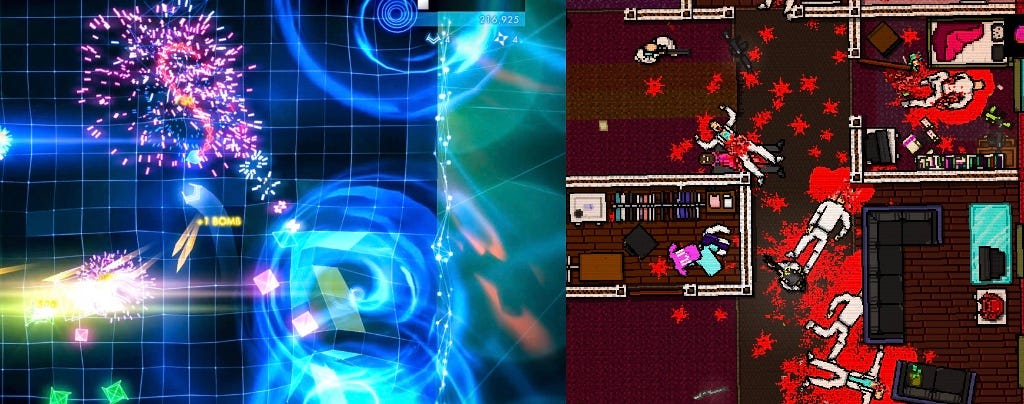Trending
Opinion: How will Project 2025 impact game developers?
The Heritage Foundation's manifesto for the possible next administration could do great harm to many, including large portions of the game development community.

Featured Blog | This community-written post highlights the best of what the game industry has to offer. Read more like it on the Game Developer Blogs or learn how to Submit Your Own Blog Post
Revival movements in art have a long history, and retro game development can learn a lot from them. Let's consider retro games in the light of two important architectural movements, Neoclassicism and Gothic Revival, and see what shakes loose.


We love making and playing “retro” games — those titles that harken back to an earlier, simpler time full of chunky pixels and chiptune audio. While video games have evolved at a lightning pace since their inception in the late 50’s, the past decade has revealed a desire to linger in another era. I think we can all agree that it’s worth exploring why developers continue to build these games, and why players still love them.
You know these games. Many of us have lived the pure flow state of Geometry Wars, the brutal simplicity of Nidhogg, and the infinite exploration of Terraria. They can have many things in common, including trends in art style and game mechanics, but most of all they feel like old souls. These games take us back to a special time, even if we weren’t around to experience it then. There’s no particular platform or year attached to these original games; they’re just from back then. So why do they work so well, and how can we harness this power?
Luckily, games are not the first medium to look back for inspiration. The rest of the art world is constantly recycling, and we as developers should take some cues. While movements like Modernism radically revolted from the past, plenty of others were consciously founded on top of it. The Renaissance was a giant leap in humanist thought, yet it was specifically based on classical teachings. The “Retro Game Renaissance” is often used to describe our current climate of old-school inspiration, but I believe we can unlock more truth by thinking of it as a Revivalist movement instead.
Since architecture is a such a blend of art and utility, it’s often compared to video games. Both disciplines are expressive and functional at the same time, and so lend each other powerful lessons in design. Revivalist movements — those philosophies that reinvigorate earlier styles — have an important history in architecture and can teach us about games. In particular, I’d like to look two revivals that affect us greatly in the 21st century: Neoclassicism and Gothic Revival.
In the 18th century the world was busy pushing its boundaries in the Age of Enlightenment. The era was all about reason, and concerned itself with grand ideas like liberty, science, and progress. Art mirrors life, and it wasn’t long before leaders longed for an architecture that embodied the new rationality. Europe had long valued the cultural contributions of ancient Greece and Rome (so-called “classical” civilization) for these very reasons, and recent archeological discoveries reignited interest in their philosophies. Great thinkers like Vitruvius and Palladio praised the perfection of classical building for centuries, elevating it to the top of Western design philosophy.

Classical: Parthenon and Pantheon
This was also an era full of revolution and democracy. If democracy was founded in the great halls of Athens, what better heritage would serve the free men of this new world? Leaders like Napoleon and Thomas Jefferson latched onto this dream, returning to classical styles for public building. An architectural style was thus revived as a powerful tool for propaganda.

Neoclassical: Cathedral of Vilnius and the US Capitol
Neoclassical buildings became the new standard for political and institutional projects. Similar to their ancient predecessors, structures of the revived style focused on impressive columns, blank walls, and simple geometric shapes. Neoclassicism still conveys logic, just as it did in the Enlightenment. These buildings exude an air of confidence and importance — we continue to design them for government buildings, banks, libraries, and more.
Soon, in contrast to the logic of Neoclassicism, the Gothic Revival was to serve a different purpose. Surrounded by modernization, many artists began to focus on emotion and individual experience. There was an explosion of poetry, picturesque painting, and histories of long-vanished places. The Romantic movement was thus born, and with it a longing for the heroic and spontaneous. Neoclassicism’s sobriety was not up to the task, but architects did find a suitable style in medieval building.

Gothic: Notre Dame de Paris and Glasgow Cathedral
The term “Gothic” was originally an insulting term for the “barbaric” style that developed after the fall of Rome. Identified by its use of the pointed arch and vaulting, Gothic architecture had long represented a tumultuous past for Europe. The Romantics, longing for bygone adventure, were drawn to the castles and cathedrals of old. The Church propagandized the Gothic Revival as a tool for recruitment, and many great thinkers promoted this return to the “one true Christian architecture” to save society.

Gothic Revival: Houses of Parliament and St Patrick’s Cathedral
Architects started with medieval stonework, but expanded the style to accommodate large and complex projects of all types. In so doing, Gothic Revival buildings became omnipresent for churches and colleges to this day. The extreme verticality of the style can still make us gaze upward and feel part of something dramatic.
What can we learn from these very different yet related movements? How does the endless cycle of artistic revival apply to game design?
Reinvention will and should happen. Architecture and games rely heavily on technology. Both forms are reflections of an era’s philosophies and the tools that make them possible. The diligent artists strives to push the boundaries within today’s capabilities in every medium. And when new solutions are found, they can’t help but look backward and apply these improvements to past achievements. This is revivalism at its core. New Church movements, political propaganda, and the need for new building types were practical needs, and prove that revival movements happen for concrete reasons.
Neoclassicists used concrete, iron supports, stonecutting improvements, and more to move past the constraints of ancient Greece. Gothic Revivalists built higher and lighter walls than their medieval counterparts, using similar advancements in materials and building methods. Both revivals spawned buildings larger and more complex than their predecessors, and they also managed to retain the essence of the initial styles. With improvements in memory, processor speed, networking, etc., retro game developers are applying our advantages to classic approaches. For me this is the holy grail of retro game design: to capture the magic of early game development, while streamlining and improving the experience.
Perspective takes time. Art is constantly evolving. How can we distinguish the good design from bad without the benefit of hindsight? One great benefit of revival movements is that they reveal what we find important. By returning to past work, artists acknowledge its quality and therefore improve the state of art going forward. Retro games are, among other things, an acknowledgement that particular approaches make good designs. They remind us that successful ideas can make us feel and experience great moments.
Revivals also maintain continuity. As time creates distance between games old and new, developers and players want to feel a part of a tradition. They find that connection by revisiting and evolving past games. Just as architects praised a return to “pure” building methods and the public lauded the resurgence of “true” style, games too feel this pull to be part of a long heritage. This constant search for meaning is inherent to all art forms.

Classic: Robotron and The Legend of Zelda
Nostalgia is real. Both styles, especially Gothic Revival, were notable for a collective longing for times gone by. Nostalgia is a word often applied to retro games, and it’s a hallmark of revival movements.
However, it’s important to note that Revivalists were not nostalgic for childhoods of gothic architecture — those centuries were already long dead. Their nostalgia was generalized to a romanticized idea of the past. Retro game nostalgia is often confused for a literal return to our younger days, but aiming for that particular feeling is unpredictable for each player. It’s also more unrealistic with every passing year, as fewer gamers experience the original games growing up. So while nostalgia is important, it needs to guide us at a high level instead of letting us replicate individual titles or our own unique experience. We should always aim to revive the essence of what made them great at that time.
Revival is both form and function. The retro game revival is multifaceted, including many aspects of older games. I believe the above architectural movements reveal this in a way we can appreciate. While one illustrates the resurgence of how things work, the other is more about how they feel.
Neoclassicism was logical and functional. Classical buildings were based on columns and simple walls, which created places of simple elegance and beautiful proportions. In reviving this style, architects were returning to rational and approachable structures that were easily understood by the viewer. Retro game design follows this principle with an emphasis on simplicity: straightforward mechanics, intuitive gameplay, and short sessions are common features of this revival. Buildings and games need to satisfy functional requirements, and this return to basics is cyclical to both.
The Gothic Revival was driven more by aesthetic reasons. Because the Romantics were entranced by fantasy and drama of the middle ages, this revival was more emotional. The movement’s towers, battlements, and stained glass all served this desire. Likewise, retro games are usually dripping with style, and you can see the parallels in their presentation. Today’s technology has breathed new life into pixel art, traditional flip book animation, low-poly 3D modeling, and more. Chip tunes and retro sound design are bigger than ever. These “artistic” developments make sure that retro games feel genuine, and keep the movement satisfying as a whole.
Neoclassicism and Gothic Revival declined toward the beginning of the 20th century. Newer movements like Modernism became more relevant as the Machine Age took over. But even Modernism died down with time. Games have had many many such sub-movements, often defined by hardware. The early era of the challenging arcade game like (Pac-Man, Donkey Kong), the much-loved LucasArts PC adventure game (The Secret of Monkey Island, Day of the Tentacle), and the low-poly 3D action game (GoldenEye, Metal Gear Solid 2) all evoke a particular set of feelings. We game developers should try to understand our current work in the context of movements, as all artists must.

Retro: Geometry Wars and Hotline Miami
Over time our revived works tend to merge with their originals. Consider Paris’ Notre Dame cathedral and London’s much later Houses of Parliament. Many people would consider them simply gothic, despite their major stylistic departures. And that’s okay — they elicit similar feelings, and they succeed as gothic structures in general. Retro games are already doing this, blurring the line between what was old and what is new. I think this is a final victory for any revival movement, as it proves our understanding of underlying quality for any art. The classic format of today’s Killer Queen is still amazing in an arcade environment. The portable perfection of Tetris on Gameboy is still alive and kicking on mobile. Imitation is the sincerest form of flattery, and revival movements like this give credit to the supreme achievements that came before.
So let’s drive onward. Federalist and Carpenter Gothic architecture evolved as further changes to Neoclassicism and Gothic Revival. Let’s follow this example, using history for inspiration, but always changing. Who knows when we’ll see the game development version of Modernism, and how it will take us to the next level. Until then, the past is a great key to the future.
Read more about:
Featured BlogsYou May Also Like